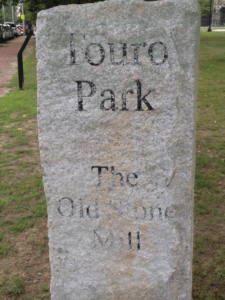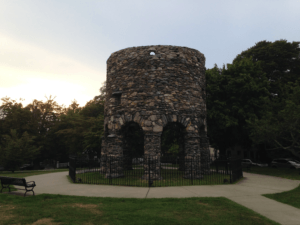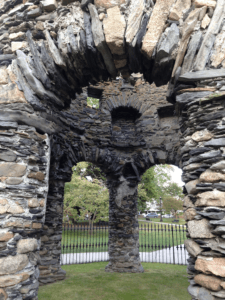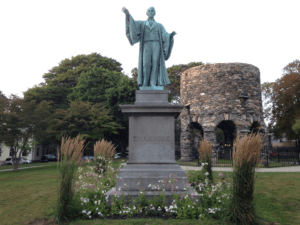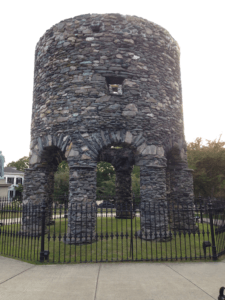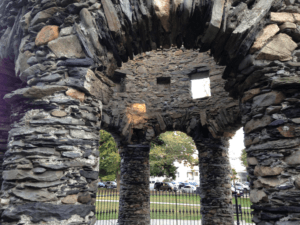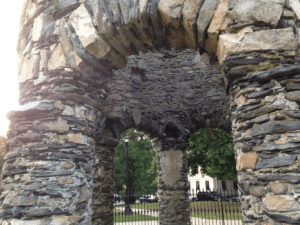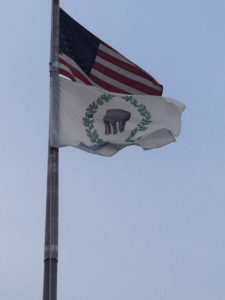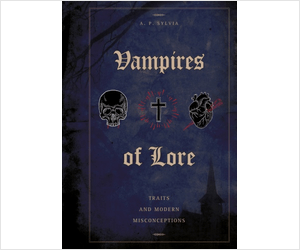The coastal town of Newport, Rhode Island is famously known for its Gilded Age mansions. Lesser known is a structure that looks like it came right out of the Middle Ages. Sitting in a small park, it’s the remnants of a round tower built of stone. The origins of the Newport Tower have been a source of public debate since at least the first half of the 19th century. A variety of theories exist, many asserting that the tower predates the arrival of Columbus.
The Newport Tower sits in the middle of Touro Park. The structure is about 18 feet in height, constructed of rough-hewn stone mortared together. The tower’s base consists of eight columns arranged in a circle, forming eight arches. The stonework is all that’s left – the roof and floors are gone. Looking up into the tower, you’ll notice notches for floor beams and the remnants of a fireplace. As you walk around it, you’ll also see various openings in the upper wall for windows. Encircling the whole thing is a rather dignified wrought iron fence.
In regards to the Newport Tower’s origins, the mainstream theory is that it was a windmill built by Governor Benedict Arnold in the 17th century. (He was an ancestor of the Benedict Arnold known from Revolutionary War history.) In the governor’s 1678 will, he references “my stone-built wind-mill.” Naturally, this is a key piece of evidence in the tower debate. However, the design of the tower, with its columns and arches, seems unlike a standard windmill. One would assume it should have a more solid, enclosed base. To counter this assertion, proponents of the mainstream theory would point at England’s Chesterton Windmill, built in 1632, which has a similar design. The tower has often been called the “Old Stone Mill” because of this history.
But did Arnold actually have the tower built, or did he just repurpose a preexisting structure? And though it’s similar to the Chesterton Windmill, the Newport Tower is not exactly the same design. It’s these notions that open the door to a myriad of theories.
One explanation that gained prominence in the 19th century is that Vikings constructed the tower. Carl Christian Rafn, who was Secretary of the Royal Society of Northern Antiquarians at Copenhagen, proposed this theory in 1837. Rafn believed that Scandinavians built the tower in the early 12th century to serve as a Christian baptistery. He felt the tower was similar to medieval structures found in the north and west of Europe. (Perhaps Reginald’s Tower in Ireland serves as an example.) Additional Viking-related theories have been subsequently proposed.
Another theory attributes the construction of the tower to the Knights Templar. Specifically, some believe that Henry Sinclair, Earl of Orkney, was a member of the famous order and led an expedition to North America in the late 14th century. In this scenario, the tower is the remains of a church built by the Templar and part of a planned colony that didn’t materialize. In regards to the tower’s architecture, Templars were known to build round churches (such as London’s Temple Church).
The theories don’t stop there. Dutch, Irish, Portuguese, and Chinese origins have all been proposed. But the mysteries of the tower go deeper than who built it. It’s been asserted that the tower’s windows were positioned to align with astronomical events and celestial bodies. Also discussed is how, on the winter solstice, a shaft of light will shine onto an oval-shaped keystone. Thus, even the purpose of the tower becomes enigmatic.
At 152 Mill St, across from Touro Park, is the Newport Tower Museum. It’s run by Jim Egan, who has proposed his own theory on the tower’s origins. To briefly summarize, Egan asserts that an English expedition built the tower as a fort in 1583. The architectural design came from famed Elizabethan scholar and courtier John Dee. It was Dee’s intent that the tower would be a tool for tracking time via its astronomical alignments. Unfortunately, I haven’t been able to visit during the museum’s normal open hours, but it’s something I’d like to do.
Another piece of evidence in the Newport Tower debate came in 1993, when mortar from the structure was subjected to radiocarbon dating. The results showed that the sample dated from sometime between 1635 and 1698 (with 95% confidence). This would naturally support the Arnold-origin theory. However, the tower debate still continues, as some have questions about the accuracy of the test.
The Newport Tower is unlike other colonial structures we’re used to seeing – it looks out of place and out of time. It’s not surprising that all this lore, whether it’s knights or Vikings, has sprung up around it. Unless some startling new evidence comes to light, it seems the case will never be closed to everyone’s satisfaction – and maybe that’s okay. After all, who doesn’t enjoy a good mystery?
To find Touro Park, just head to the intersection of Mill Street and Bellevue Avenue. There is no adjacent parking lot, so the immediate option is street parking. The park is small, so you’ll notice the tower straightaway.
Location:
Intersectin of Mill St. and Bellevue Ave.
Newport, RI 02840
Sources:
Baker, Joe. “Towering debate.” NewportRI.com. December 20, 2012. http://www.newportri.com/article/20121220/ENTERTAINMENT/312209922.
Barstad, Jan. “The Newport Tower Project: An archeological investigation into the Tower’s past.” Chronognostic Research Foundation, Inc. September 21, 2007. http://www.chronognostic.org/pdf/tower_project_report_2007.pdf.
Barstad, Jan. “Who Built the Newport Tower?” The Arizona Center for Medieval & Renaissance Studies. Accessed November 18, 2018. https://acmrs.org/about/online-resources/NewportTower.
Egan, Jim. “Who built the Newport Tower?” Newport Tower Museum. Accessed November 18, 2018. http://newporttowermuseum.com/styled-4/index.html.
Flynn, Sean. “Carved in stone?” NewportRI.com. October 4, 2014. http://www.newportri.com/44136c7b-d4ff-5103-8056-3280a922beee.html.
Flynn, Sean. “Tower of mysteries.” NewportRI.com. October 10, 2016. http://www.newportri.com/f92fdce3-5456-5be2-b8ea-f103b3118348.html.
Hatfield, R. G., “The ‘Old Mill’ at Newport: A New Study of an Old Puzzle.” Scribner’s Monthly 17, no. 5, March 1879 in The Century: A Popular Quarterly, Volume 17. Scribner & Company; The Century Company, 1878. https://books.google.com/books?id=EOoGAQAAIAAJ.
Loviglio, Joann. “Mystery still surrounds stone tower in Newport.” southcoasttoday.com. January 10, 2011. http://www.southcoasttoday.com/article/19970326/life/303269953.
Written by A. P. Sylvia

